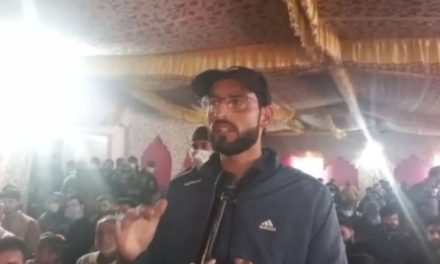![]()
KNZ NEWS DESK
Rafiqa Begum is a little over nine years short of celebrating her 100th birthday. She was born on 18 March 1927. The last Dogra monarch Hari Singh had ascended the throne only two years earlier.
At the age of 90 years, 10 months and 17 days, Begum has been enrolled in J&K education department as a casual employee for regularisation of her services under a new job policy announced by the government last year.
Figuring at serial no. 8976 in the list of 14616 “casual laborers and other workers” prepared by the department, Begum, wife of Ghulam Mohammad Gojri of Nutnussa Handwara in Kupwara district, is shown to be working in government middle school Nutnussa.
But Begum is not the only shocking entry to the lists prepared by at least 30 different departments. Khatija Bano of Anantnag district is only two years and five months younger to Begum. At 88, Bano too has made it to the list as a casual laborer in the zonal education office Bijbehara. Wife of Abdur Rehman Badder, Bano was born on 1 March 1930.
There are more such entries, some of them on the opposite end of the age scale. A minor, Ubaid Farooq son of Farooq Ahmad Rather of Narapora, Keller Shopian, is shown to be working as casual laborer in forest department in Shopian forest range.
Aged 14 years, 9 months and 15 days, Ubaid is the youngest ‘casual labourer’ to claim right to regular services.
In Kupwara, 15-year-old Farkeet Ahmad Lone son of Ghulam Mohiudin Lone is the second youngest minor enrolled by the education department as a casual laborer in primary school Banni. He was born on 20 June 2002.
While the retirement age for government employees in J&K is 60 years, a person becomes eligible for government job only after attaining 18 years of age.
A senior official in the PHE department said that for non-regular employee like casual laborers or daily rated wagers there is a minimum age bar of 18 years. But he said no upper age limit or retirement age had been fixed for these categories of employees.
“The thumb rule was as long as a worker delivers he will be entitled to wages,” said the official.
The government officials insisted that mere enrolling themselves with the departments doesn’t make people eligible for jobs. They said each case would be scrutinized for the eligibility as per laid down rules. However, the entry of people as old as the 90-year-old Rafiqa Begum and 14-year old Ubaid raises questions on the entire enrollment process.
The lists of these casual laborers and other workers have been prepared by the departments under Aadhar-based biometric information and skill profiling. Under the process, each person was required to submit his Aadhar number apart from his date of birth and qualification certificates and other required documents at the time of enrollment.
“I was asked to personally submit 12-digit Aadhar details and other documents by the department. All these details were checked by an official for my enrollment. I believe the same process would have been followed in other cases in the department as well as by other departments,” said a job aspirant who is working as a casual laborer with education department which has enrolled Rafiqa Begum.
Another youth who is working as a casual laborer in the PHE department corroborated the remarks of the youth from the education department.
“We too followed the same process.”
The government had in November last year announced it will regularise services of 60,000 daily-wagers and casual labourers in various departments to provide them a sustainable livelihood. Under this policy the casual workers would get monthly consolidated remuneration ranging from Rs 10,000 to Rs 24,000.
The announcement came after an fresh survey by finance department had revealed there were 1,00,501 casual workers and other non-regular employees of 13 different categories working in different departments.
In 2014, a similar exercise which was undertaken by the previous government had shown that there were 61,464 non-regular employees working with different departments, around 40,000 workers less than the workers enlisted under the new survey. The government has this time defended the increase in number of workers saying it included “all categories of workers”.
But the lists are full of examples of persons who were born in 1930s and 1940s. There are also names of minors included in these lists whose date of birth varies from 2000 to 2003, many of them ineligible for the job as on date.
Take another example. Bua Ditta son of Ganjo Singh of Karandi of Samba in Jammu was born on 1 January 1936, 11 years before the partition. The 82-year old man has got himself enrolled as a casual labourer in PHE sub-division Samba. He is the eldest person to figure in the 12490-page list prepared by the PHE department.
Apart from one nonagenarian, there are around 120 people in the age group of 80s and 70s in the lists. In the category of minors, Ubaid is the youngest one followed by four boys aged 15 plus but less than 16 years of age. Similarly, there are another 16 minors whose date of birth is 2001 and are less than 18 years of age. There are another 127 persons born between 1998 and 2000 figuring in the list.
The commissioner/secretary finance Navin K Choudhary said by just enrolling themselves with different departments people in no way can claim entitlement to jobs.
“The list of (eligible persons) will come from the departments after scrutiny of all individual cases, their documents and all files. People were asked to enroll themselves under biometric system but it (the lists) has no validity in the sense that it is not verified as no document has been scrutinised,” said Choudhary.
As of now, he said there is only a simple Aadhar based list which will be scrutinised.
“It is preliminary enrollment by different departments who will have to collect all evidences like engagement orders and records for payment of wages to start processing the cases. The cases of each individual will come to finance department after scrutiny and then empowered committee will take up the cases,” he said.
The commissioner/secretary said the departments who have enrolled the people will have to back their claims by all required documents.
In J&K, the number of jobless educated youth was over six lakh in 2016, according to information tabled by the government in Assembly. The state government is the largest employment provider in the state in absence of fully developed industrial and other job generating sectors. There are over 5 lakh employees working with the government in the state.
























